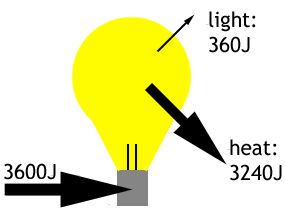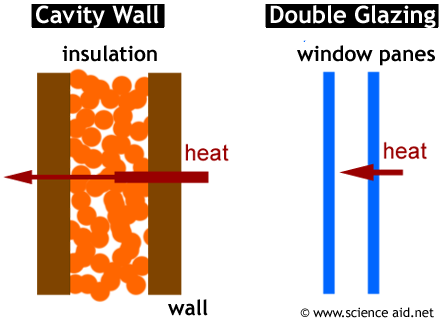Energy efficiency and Insulation
Edited by Jamie (ScienceAid Editor), Taylor (ScienceAid Editor)
Types of Energy
Here are some of the different types of energy:
| Type | Explanation |
|---|---|
| Thermal and Light | No explanation required. |
| Kinetic | This is the energy in movement, like a train in motion. |
| Chemical | This is found in chemical bonds and can be stored. |
| Nuclear | The energy from an atom's nucleus. |
| Potential | Another energy that can be stored, there are two types:
Gravitational potential energy (GPE) - the sort a person has a lot of before they jump off a bridge with a bungee rope. And elastic, the sort that the rope has when it is being pulled by the weight of the jumper |
Energy Efficiency
To understand energy, you need to understand this: it is not something you can see or feel or sense in any direct way - it's just there. Secondly, energy does not disappear or get 'used up' but rather is converted or transferred into another form of energy. And this is where efficiency comes in.
Let's use the example of a light bulb! You don't want it to do anything other than produce light. The inefficiency of the old traditional light bulbs we all should be getting rid of, is they also produce heat, and quite a lot of it.
A 60W lightbulb turned on for one minute. A watt is equivalent to a joule per second, so it uses 3600J. The bulb produces 360J of light energy in that minute, but it also produces 3240J of heat energy. To calculate the efficiency...
Efficiency = [useful energy / total energy] x 100% = [360 / 3600] x 100% =10%
On the other hand, an energy saving bulb is designed to produce as little heat as possible. In a similar experiment, but with an energy saving bulb, it produces only 80J of heat. So to get the same light output the bulb only needs to use... 360J + 80J = 440 440J / 60s = 7W
Insulation
Insulation is also another way of making something more efficient - it cuts down on the amount of heat energy leaving where it is required. You can prevent heat being lost from the house by having double glazing or cavity wall insulation.
Kinds of Insulation
- 1One of the ways that heat is transferred, is by convection. This is where warm air rises (as the density decreases), away from the source of heat, but then cools (density increases) and sinks.Convection.Advertisement
- 2This is when the gap between the two panes is too small to allow the movement of air. As well, air is a poor conductor, so less heat escapes if it has to travel through air, then solid, then air and then solid again - until it finally reaches air.Double Glazing.
- 3With this process, the gaps or cavities between the two walls are filled with an insulating material, which creates many small pockets of air that prevent heat from escaping. Older homes only have one wall, and so are less energy efficient.Cavity Wall Insulation.
Referencing this Article
If you need to reference this article in your work, you can copy-paste the following depending on your required format:
APA (American Psychological Association)
Energy efficiency and Insulation. (2017). In ScienceAid. Retrieved Apr 25, 2024, from https://scienceaid.net/physics/electricity/energy.html
MLA (Modern Language Association) "Energy efficiency and Insulation." ScienceAid, scienceaid.net/physics/electricity/energy.html Accessed 25 Apr 2024.
Chicago / Turabian ScienceAid.net. "Energy efficiency and Insulation." Accessed Apr 25, 2024. https://scienceaid.net/physics/electricity/energy.html.
If you have problems with any of the steps in this article, please ask a question for more help, or post in the comments section below.
Comments
Article Info
Categories : Electricity
Recent edits by: Jamie (ScienceAid Editor)










